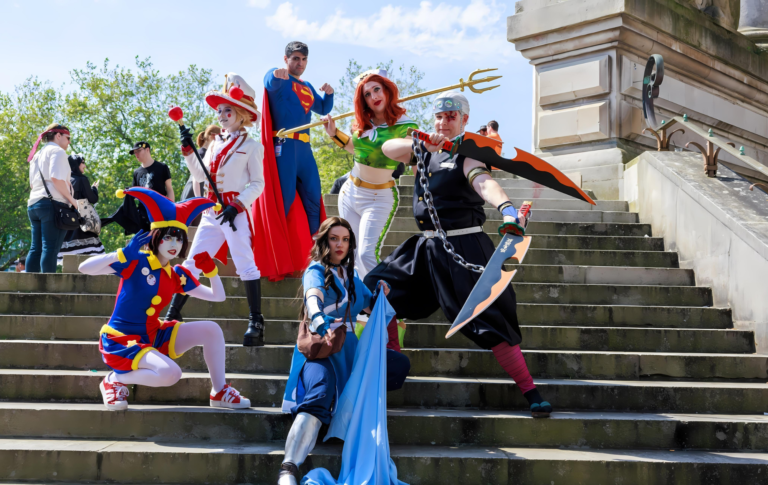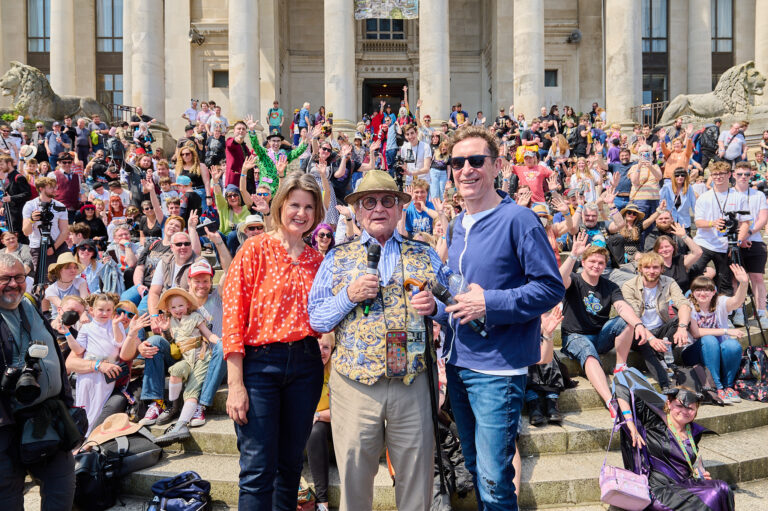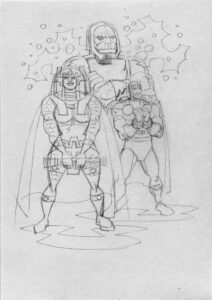
Tell us a bit about yourself – how did you get started in comics?
I grew up in New Zealand reading them – they were always around. I more or less taught myself to read from studying Carl Barks’ Donald Duck and Uncle Scrooge comics, and they were given to my brother and me whenever my mum thought we deserved a treat, or just wanted to keep us quiet for a while – we’re talking Disney, Harvey, Gold Key Hanna-Barbera stuff mainly, with a few black and white Australian DC reprints thrown in (which is why I still prefer Kirby in black and white to this day, probably). The moment I got serious about making them was when I was about 6 or 7 years old – as an art exercise in school, the class were given strips of paper and told to draw a comic strip. Most of the class drew a 3 or 4-panel strip, as expected – but I, for whatever reason, covered both sides of the paper with a dozen or more panels. Some switch had flipped in my brain and I felt like I’d found my thing, I guess. Anyway, from that moment on I never seriously considered doing anything else as a career.
Jump forward a couple of decades: after making comics with my brother Andrew when we were growing up – often with Andrew writing and me drawing, but we switched around a bit – we put together a minicomic, ART DEKKO, featuring humour strips about a louche tuxedo-wearing sadistic layabout, and convinced our local comic shop to carry a few. We sent some copies to a few publishers in America as well, and Fantagraphics replied with an offer of an ART d’ECCO one-shot (they requested a change in spelling because there were a couple of other characters called Art Dekko knocking about). So suddenly we had an American publisher, and at that point it seemed like leaving New Zealand to try to live and work in comics somewhere where there was an actual comic industry was an achievable goal. (New Zealand has a huge amount of cartooning activity, but – certainly in 1990, in those pre-internet days – you couldn’t sustain a career there, because the population is quite small.) So I saved up and bought a ticket to London, where I hassled editors at conventions, arranged appointments and generally refused to go away until I was getting work. (There was a bit more to it than that, but in broad strokes that’s the story.)
End of boring secret origin!
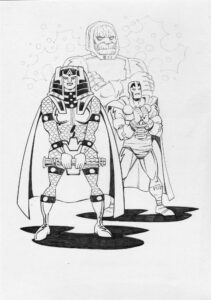
What is it, in particular, about comics that you love?
There are a lot of things. The immediacy of it: you can experience something, draw a strip about it and post it online the same day, to potentially be seen by anyone in the world. The potential for millions of different art styles, no two completely alike. The way comics can play with time like no other medium, showing different moments simultaneously, which allows for some playful misdirection that doesn’t work in prose or on film at all. The control of timing they give you as an artist, which is a particular gift for anyone doing anything funny. The fact that it’s the only visual medium in which a single person can produce a work of substantial length and complexity without requiring any collaborators whatsoever. The fact that you can bring in collaborators with strong voices of their own, and your work becomes something else entirely that can surprise and delight you.
I quite like comics.
I was lucky enough to bag a Spider-Man commission from you at Thought Bubble a few months ago, and sat in the cafe afterwards marvelling over it with another cartoonist. We agreed you produce the nicest commissions in comics, but were arguing about your materials and I kicked myself for not paying more attention. Could you shine a little light on what goes into one or do you consider those trade secrets?
It’s no great secret. Really, it’s a style that was born out of necessity: when people first asked me to do sketches for them, I would feel awful that anything I did on a convention floor would always look rushed and half-finished, and that self-consciousness affected my enjoyment of the drawing, which affected the quality in a self-reinforcing spiral of dreadfulness. So I basically invented a new style that didn’t look like my print style, to sidestep the negative comparisons entirely and free me up so I could actually enjoy doing them.
In a nutshell, I generally work on paper that isn’t white, usually beige or light brow, and do a quick drawing with some kind of pen that won’t run if it gets wet – for a while now, it’s been a Mitsibishi Micro Uniball pen. Then I lay some flat colour on top of the drawing – often markers, but I also use refillable brush pens with coloured inks – and, once that’s down, add some highlights, shadows and textures with coloured pencils. Then I use a fine-tipped Posca paint marker to add some white highlights to make things pop against the off-white paper. Ta-dah!
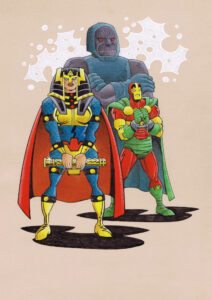
I can’t decide if Hotel Fred or your Muppets comics are the funniest comics I’ve ever read. Do you think a lot about comedy and comedic theory or are you just a naturally gifted genius?
Well, first, thank you, I’m blushing! But I’m no genius, I work at it. I remember years ago watching an interview with John Cleese on TV – I think it was a South Bank Show – where he said he wasn’t especially gifted as a comedy writer, but the great advantage he had over most other comedy writers is that he never had any illusions that writing comedy was easy, so he was always prepared to put the work in. That really stuck with me. I do read up on comedy theory whenever I can (most recently, I read Joel Morris’ excellent BE FUNNY OR DIE, if you’re looking for one you can get your teeth into) and I don’t know how much of it I retain, but I suppose some of it must sink in. And then there’s the fact that I’ve just got a lot of experience writing funny stuff under my belt at this stage, which I’m sure doesn’t hurt. I’m also an avid comedy consumer, so reading, hearing or watching something funny can often inspire me.
What are you working on right now and what do you have coming out this year?
Let’s see… I’ve just started a strip for MONSTER FUN called “Sally Astro”, which I’m writing and drawing, about a girl alien on Earth – the first episode of that should be in the June issue. I’ve also recently started a new regular feature for DOCTOR WHO MAGAZINE called “Loose Ends”, which Jonathan Morris writes and I illustrate – there have been a couple of those so far. I’ve written a Darkwing Duck spinoff series called JUSTICE DUCKS, drawn by Carlo Lauro, the second issue of which recently came out – there’ll be five issues in all. I’ve just handed in a set of scripts for a new run of PANDORA PERFECT in 2000AD. My serial “Taniwha” continues in Soaring Penguin’s MEANWHILE anthology – I’ve done another twelve pages for the next issue. And HISTORY COMICS: THE PROHIBITION ERA, written by Jason Viola and drawn by me, will be out from First:Second Books in October this year.
There’s also the diary strips on my Patreon page, the best of which I share on Instagram and Bluesky under the @hotelfred account. I’ll have a new self-published collection of those out later in the year.
What will you have for sale at the show?
I’ll have the usual nonsense – three volumes of my self-published Diary Comic collections and other self-published creator-owned things; various books from proper publishers that I’ve worked on like PANDORA PERFECT, BILL AND TED and THE GOON; some original artwork, sketches and whatnot. Whatever I can fit in a suitcase! (My self-published books are available from my web store as well, if you go to www.hotelfred.com and follow the links.)

